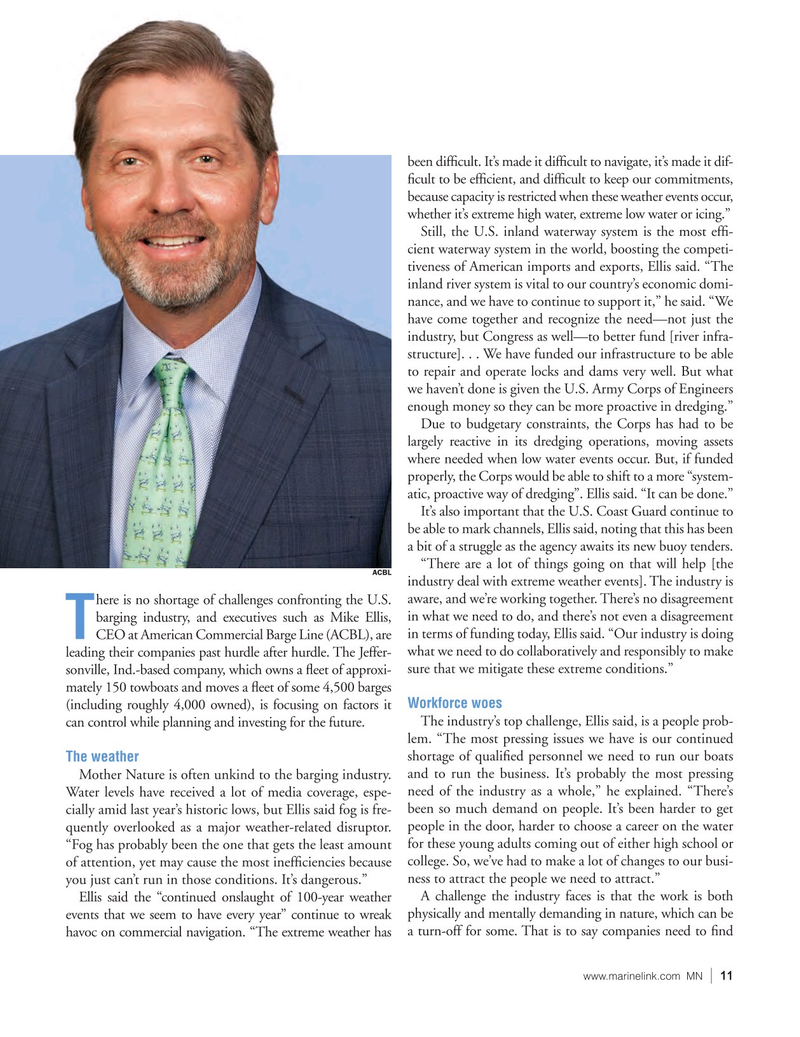
Page 11: of Marine News Magazine (June 2023)
Combat & Patrol Craft
Read this page in Pdf, Flash or Html5 edition of June 2023 Marine News Magazine
been dif? cult. It’s made it dif? cult to navigate, it’s made it dif- ? cult to be ef? cient, and dif? cult to keep our commitments, because capacity is restricted when these weather events occur, whether it’s extreme high water, extreme low water or icing.”
Still, the U.S. inland waterway system is the most ef? - cient waterway system in the world, boosting the competi- tiveness of American imports and exports, Ellis said. “The inland river system is vital to our country’s economic domi- nance, and we have to continue to support it,” he said. “We have come together and recognize the need—not just the industry, but Congress as well—to better fund [river infra- structure]. . . We have funded our infrastructure to be able to repair and operate locks and dams very well. But what we haven’t done is given the U.S. Army Corps of Engineers enough money so they can be more proactive in dredging.”
Due to budgetary constraints, the Corps has had to be largely reactive in its dredging operations, moving assets where needed when low water events occur. But, if funded properly, the Corps would be able to shift to a more “system- atic, proactive way of dredging”. Ellis said. “It can be done.”
It’s also important that the U.S. Coast Guard continue to be able to mark channels, Ellis said, noting that this has been a bit of a struggle as the agency awaits its new buoy tenders.
“There are a lot of things going on that will help [the
ACBL industry deal with extreme weather events]. The industry is here is no shortage of challenges confronting the U.S. aware, and we’re working together. There’s no disagreement barging industry, and executives such as Mike Ellis, in what we need to do, and there’s not even a disagreement
T CEO at American Commercial Barge Line (ACBL), are in terms of funding today, Ellis said. “Our industry is doing leading their companies past hurdle after hurdle. The Jeffer- what we need to do collaboratively and responsibly to make sonville, Ind.-based company, which owns a ? eet of approxi- sure that we mitigate these extreme conditions.” mately 150 towboats and moves a ? eet of some 4,500 barges (including roughly 4,000 owned), is focusing on factors it Workforce woes can control while planning and investing for the future. The industry’s top challenge, Ellis said, is a people prob- lem. “The most pressing issues we have is our continued
The weather shortage of quali? ed personnel we need to run our boats
Mother Nature is often unkind to the barging industry. and to run the business. It’s probably the most pressing
Water levels have received a lot of media coverage, espe- need of the industry as a whole,” he explained. “There’s cially amid last year’s historic lows, but Ellis said fog is fre- been so much demand on people. It’s been harder to get quently overlooked as a major weather-related disruptor. people in the door, harder to choose a career on the water “Fog has probably been the one that gets the least amount for these young adults coming out of either high school or of attention, yet may cause the most inef? ciencies because college. So, we’ve had to make a lot of changes to our busi- you just can’t run in those conditions. It’s dangerous.” ness to attract the people we need to attract.”
Ellis said the “continued onslaught of 100-year weather A challenge the industry faces is that the work is both events that we seem to have every year” continue to wreak physically and mentally demanding in nature, which can be havoc on commercial navigation. “The extreme weather has a turn-off for some. That is to say companies need to ? nd www.marinelink.com MN 11|
MN June23 Layout 1-17.indd 11 5/19/2023 4:07:54 PM

 10
10

 12
12
